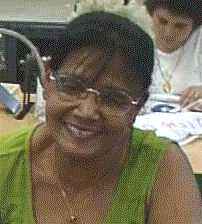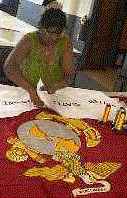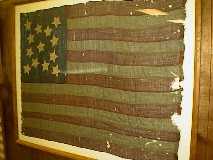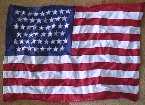Star Seamstress

 Monday, August 10, 1998, Verona, New Jersey -
Anhillia Harnandan likes the Marine Corps, but she loves Navy Admirals. Both have beautiful flags - and flags are her business - but the Admiral's flag is filled with intricate embroidery - just the challenge she loves, and, when completed, its elegance is a reward in itself.
Monday, August 10, 1998, Verona, New Jersey -
Anhillia Harnandan likes the Marine Corps, but she loves Navy Admirals. Both have beautiful flags - and flags are her business - but the Admiral's flag is filled with intricate embroidery - just the challenge she loves, and, when completed, its elegance is a reward in itself.
"I like real special detail work," she says. "The harder a flag is to sew, the more I enjoy making it." Her love of detail and her incredible patience have proven to be very successful for Guyanan-born Harnandan, now a supervisor who manages and trains dozens of workers. When she left Guyana eleven years ago, she had never used an electric sewing machine, and now she has mastered many of them. "I love learning new things," she says. "I love it when a new machine comes in and I learn how to use it."
Sewing (or embroidering by machine, actually) is a meticulous art. Using the Bonnaz, a circular stitch, and the Schiffli, a straight stitch, Harandan may spend ten to twelve hours sewing an Admiral's flag. It usually takes months for a person to comfortably sew straight lines and over a year to learn to sew letters.
What country's flag is the most difficult one to make? First a little background.
The Annin family were sail makers in New York Harbor in the 1820's, according to Frank Granelli, salesman for Annin. Ships arrived daily from around the world and some would need a new flag to fly for their home country. The Annins made one or two flags, then three or four...
Like any sewing project, making an item for the second time is is easier than the first, because you now have the pattern. The Annins gathered patterns for each country as they made its flag, and soon, when a captain would ask if they could make a flag for him, that flag would already be made and he could have it immediately.
This put Annin far ahead of anybody wishing to be in the flag business and, 1n 1847, Annin became the first "Official Flag Maker to the World."
The company presently makes over 10,000 items, including 220 country flags. They are the official flag supplier to the United Nations, which is not an easy job. Flags are designed with different height-to-width ratios and Annin must make them all consistent, per the U.N. The only odd-shaped country flag in the world is flown by Nepal - their's is a double pennant.

Ahillia Harnandan,
one of a few good flag makers,
working for the Marine Corps.
Ahillia Harnandan climbs the two flights of stairs each day to the custom flag department of Annin, where she makes beautiful, colorful flags. Here she sews the most intricate flag designs in the world. "I like to learn more every day," she says, revealing another trait of her success. This Guyanan citizen, who has lived in the U.S. since 1983, has worked at Annin for eleven years.
Like thousands of aliens working in the U.S., Harnandan is applying to become a U.S. citizen. She didn't flee persecution in Guyana, she didn't catch the last relief plane out of the country. Ahillia Harnandan came to America with her husband and two children for the same reason millions and millions of our forefathers and friends immigrated here. "I came here for the work and the money," she says.
She pays taxes just like a citizen, but she will not get as many benefits, so she is becoming a U.S. citizen for the same reason as millions of our forefathers; "for the benefits," she says.

This thirteen star flag was made in 1777, according to Frank Granelli of Annin, the same year Congress adopted the circular pattern of stars. Later, the pattern would return to rows to accommodate more states, and it was a flag similar to this one - with fifteen stars - that inspired Francis Scott Key to pen the inspiration for our National Anthem.
In these relatively peaceful times, when our country is not threatened from invasion by other countries, it is not such an instinctive act to treasure the image of our flag. We tend to see it as a symbol of the local car lot.
I have not fought in any wars, so I can only imagine how it must have felt for soldiers, sailors and pilots to see the U.S. flag. I can imagine how frightening it was for them to venture out on a mission, stay out for days, get caught in battles, and get lost among the enemy. I can imagine how courageous they were to fight and be fought and to watch their comrades die and wonder when their own bodies would fall.
I can imagine their cold, empty fear as they made their way back to their base, almost sure where it was, never sure where the enemy was, and always ready for an attack, but, after a long battle that exhausted ammunition and men, hardly prepared for one. Prepared only to die, if they had to.
I can only imagine how incredibly beautiful the United States flag must have looked to them, flying high above their fort, their base or their ship. To them it meant safety, it meant that they were home and that this home was still theirs.

Annin makes and sells ninety thousand
of these four-by-six inch "parade" flags each week.
Some flags are very easy to make. Take Monaco; the top half is red and the bottom half is white; simply sew two pieces of cloth together. Some have intricate designs, like many of our state flags. But intricate designs can be sewn freely.
The most difficult flag to sew, say the people at Annin - and they have sewn them all - is the Stars and Bars of the United States of America.
No flag has more stripes - perfectly straight lines - to sew, and creating fifty stars symmetrically, in alternating rows of six and five stars is a great challenge. When it is finished, the flag is a real nut about perfection. Look at a U.S. flag; if even one of the stars is off by even a few threads of the cloth, or is set at a seemingly imperceptible angle, it will stand out like the sore thumb of a seamstress working a double-shift.
And that is just the sort of detail Ahillia Harnandan loves.

Since 1987, Annin has made and sold many fifty-one star flags like this one
to anyone in favor of creating another united state in our America.
Fun Flag Facts
-
The largest free-flying flag in the U.S. is hung on the George Washington Bridge, between New Jersey and Manhattan. Sixty feet tall and ninety feet wide, it is only flown on flag holidays. Made by Annin, its stars stand 36 inches high - taller than most flags themselves.
-
In the 1800's, designing U.S. flags was pretty much done by whomever made the flag. "With all the states being added so quickly, it was a free-for-all," according to Dale Coots, Marketing Specialist for Annin. The Flag Act of 1912 put some order into the design.
-
The only cloth which may be flown above the U.S. flag is the pennant of the church, by a ship's chaplain, while at sea, while holding services for personel of the U.S. Navy.
-
A flag should be between one-quarter and one-third the height of its pole.
-
All flags that ever were official U.S. flags will always be official U.S. flags, so if you have a 48-star flag in the attic, you can still fly it.
-
When a new flag is adopted, it becomes official on the next fourth of July.
-
When flying a flag at half-staff, raise it to the peak for a moment, then lower it halfway. Raise it to peak again before lowering it for the day.
-
There are seven U.S. flags on our moon, at least we put seven up there. Between the harsh sun in the day and the frigid cold at night, each flag probably lasted only a few days.
-
U.S. flags have been designed with fifty-one, fifty-two, fifty-three and fifty-four stars, should the entities of Guam, U.S. Virgin Islands, Washington D.C. and Puerto Rico decide to join.
Information for Fun Flag Facts courtesy of Annin & Co.
|